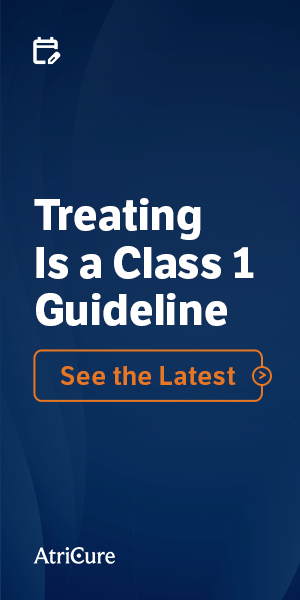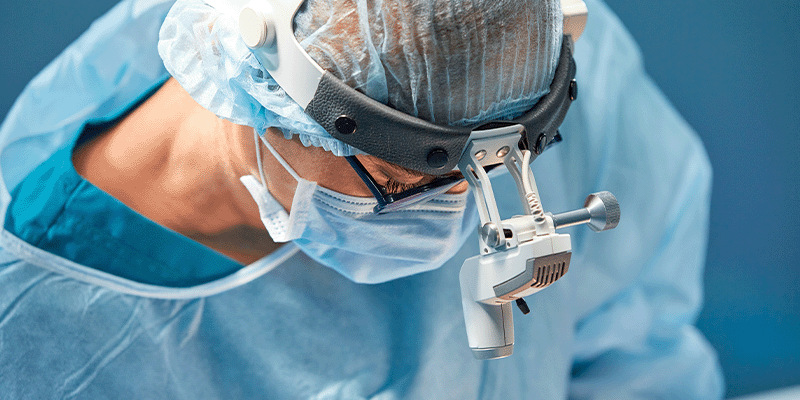What’s Driving the Shift in Afib Treatment?

You May Have Noticed
There’s a paradigm shift in the treatment of atrial fibrillation. So, what’s driving it?
1. Advances in Society Guidelines for Surgical Ablation
The previous practice of relying mostly on medical management is shifting to more proactive interventions because of the growing evidence of catheter and surgical ablation efficacy in treating Afib.
Outdated evidence that used to be relied on, such as the AFFIRM study from 2002, was limited to studying anti-arrhythmic drugs (and not surgical ablation), an older patient cohort and limited anticoagulation use. As a result of the study limitations, rhythm control didn’t show the same survival advantage that it does in more contemporary studies such as EAST-AFNET 4 (2020), CABANA (2021) and CASTLE-HTx (2023).
The first Cox-Maze procedure to treat Afib was a cut-and-sew process to reroute errant cardiac electrical activity.1 By 2002, the procedure, which was added to structural heart surgeries, used radiofrequency clamps and cryo probes to complete the lesion set.
The first guidelines for surgical ablation treatment were published in 2014,2 and over the last 20+ years, the guidelines have continued to progress. Here are some of the most recent highlights:
- Concomitant surgical ablation is a Class I recommendation.3-4
- Catheter ablation becomes a Class I guideline and first-line therapy for symptomatic patients5
- Hybrid AF™ Therapy ablation for symptomatic advanced Afib is “Advise to do”5
- Left atrial appendage exclusion (LAAE) during heart surgery has the highest (Class I) recommendation from all relevant medical societies3-5
2. Mounting Clinical Evidence
Mounting clinical evidence for the benefits of surgical ablation and return to normal sinus rhythm, especially in the last 5 years, has played a key role in the paradigm shift and prompted updated Afib guidelines from medical societies. Examples include:
- EAST-AFNET 4 demonstrated early rhythm control in recent Afib diagnosis improved outcomes vs. rate control – specifically, reduced cardiovascular death, stroke and hospitalization by 21%.6
- CABANA found that increased time in sinus rhythm was associated with a clinically consequential decrease in mortality and other prognostic events. And, also found that the predictive value of sinus rhythm was independent of the therapeutic approach that was responsible for reducing the burden of detectable Afib.7
- CASTLE-HTx found that RF ablation in end-stage HF patients with Afib reduced death or urgent heart transplantation by 45% vs. medical therapy with 88% in sinus rhythm. That was important because it showed RF ablation improves survival in severe HF, prioritizing sinus rhythm.8
Societies have modified guidelines based on new data.
- For all patients undergoing first-time non-emergent cardiac surgery procedures, concomitant surgical ablation is a Class I recommendation.9
- For patients without structural heart surgery needs—and with symptomatic Advanced Afib—Hybrid AF Therapy ablation offers a greater chance of normal sinus rhythm.5
The latest substantial guideline changes came in 2023, including:5
- Class I guideline for catheter ablation as a first-line therapy for symptomatic patients
- Hybrid AF Therapy ablation is reasonable, or “Advise to do”
3. Innovative Devices
The evolution of surgical tools has significantly advanced the treatment of Afib. Two major innovations—ablation devices and LAAE devices—have helped streamline procedures and reduce operative risk.
Ablation devices, such as radiofrequency and cryoablation probes, have largely replaced the traditional cut-and-sew technique for lesion creation. These tools allow cardiac surgeons to perform ablations more efficiently and with greater precision, minimizing procedural time without compromising patient safety.
LAAE devices, on the other hand, offer a less invasive alternative for excluding the LAA. Like modern ablation tools, LAAE devices reduce the need for extensive surgical manipulation, offering similar benefits in terms of procedural simplicity and safety.
Together, these innovations have addressed key barriers that once limited the adoption of surgical Afib treatments—namely, concerns about excessive operative time, procedural complexity, and added risk to the index operation. These concerns were especially prominent before robust clinical data supported the efficacy and safety of surgical interventions.
Surgical Ablation to Restore Sinus Rhythm
Intervention is often the best way to restore sinus rhythm for non-paroxysmal Afib patients; therefore, interventions are supplanting a mere reliance on medical management.
Surgical ablation is a superior rhythm control approach because it:10-12
- Reduces the progression of Afib
- Decreases patients’ symptomatic burden
- Is associated with better outcomes
Medical management treats associated symptoms, not the Afib itself. But Afib is a disease continuum that requires screening and proper therapy.5
Landmark studies have redefined the rhythm control advantage, building the case for why treating Afib by restoring sinus rhythm with ablation has become the standard of care. The growing data highlighting the benefits of surgical ablation is part of the paradigm shift to treat Afib earlier and more aggressively, before it progresses or exacerbates other comorbidities.
Most importantly, patients deserve the opportunity to be in sinus rhythm.


